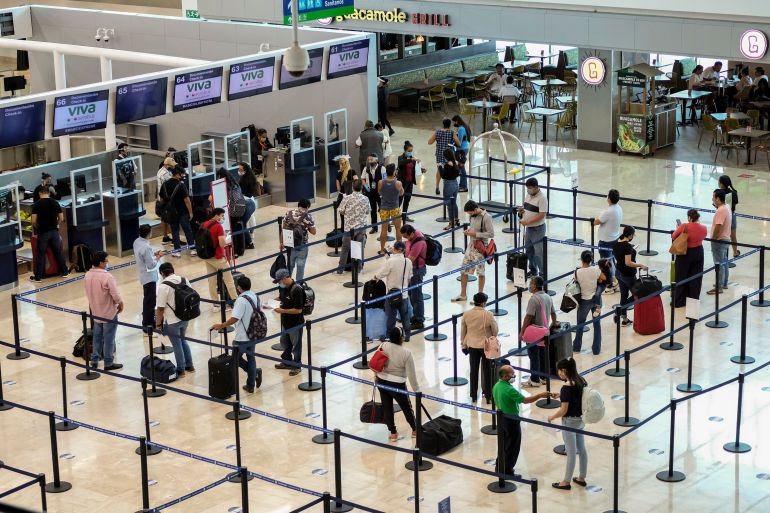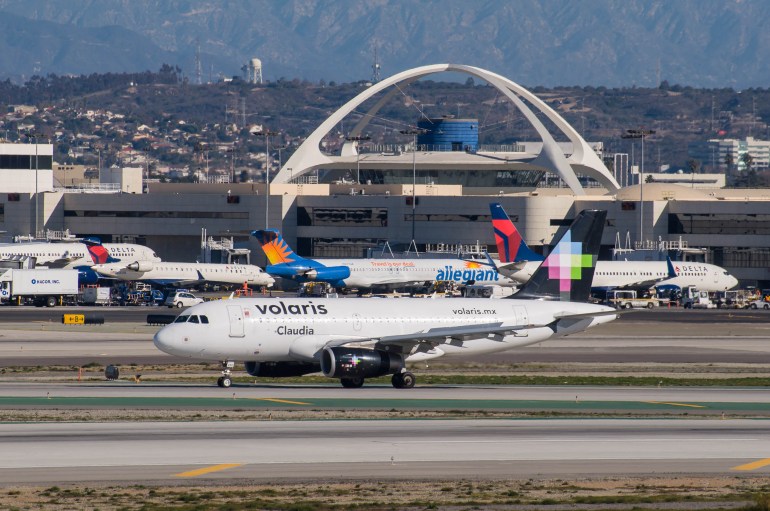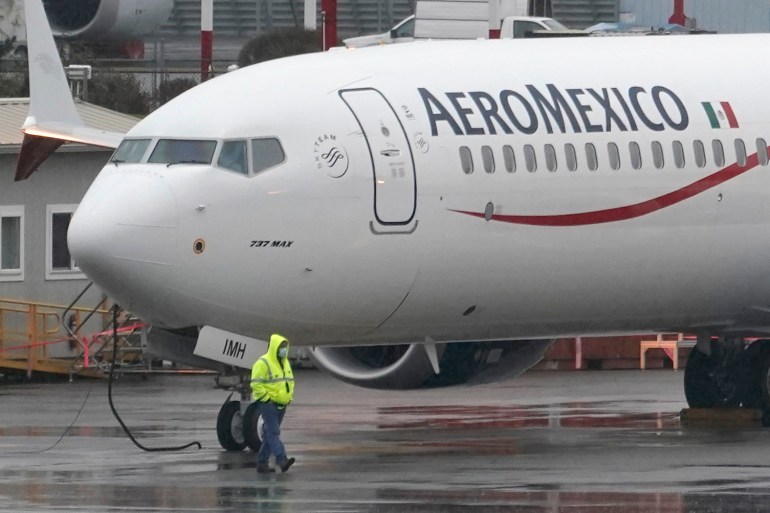Flight delay: Will Mexico’s lower FAA rating hurt tourism?
The United States Federal Aviation Administration (FAA) downgraded Mexico’s civil aviation agency’s safety rating at a time when the Mexican tourism industry is hoping to rebound by taking advantage of pent-up demand.

As many newly vaccinated Americans make vacation plans after a year of staying home, Mexico remains one of the most popular international destinations — and the country’s beleaguered tourism industry is ready for the much-needed boost.
About 10.5 million tourists from the United States visit Mexico in a typical year, and tourism accounts for 8.7 percent of Mexico’s economy, according to the Organisation for Economic Co-operation and Development. After the coronavirus pandemic took a major bite out of tourism revenue in 2020, Mexico is eager to welcome visitors again.
Keep reading
list of 4 itemsMore than 11,000 evacuated in northern Indonesia as volcano erupts
Jordan, Lebanon, Iraq reopen airspace closed over Iran’s attacks on Israel
Australian women lose bid to sue Qatar Airways over 2020 strip searches
But the skies between Mexico and the US could be a little quieter than anticipated in the coming months after the US Federal Aviation Administration (FAA) last month downgraded Mexico’s aviation safety rating from category one to category two.
Economic strategist Carlos Torres of consulting group Strategic Affairs said there could be serious consequences for the Mexican economy as a result.
“The airline industry has gone through a very difficult time in the last year, with a historic drop in passenger traffic,” Torres told Al Jazeera, explaining that the downgrade has come at a point where economic recovery and vacation season in the US would otherwise be driving more people to fly to Mexico.
With Mexican airlines prevented from adding more routes, “this positive growth in passenger traffic is not going to be met by Mexican airlines,” he explained.

The FAA downgrade also means that Mexican air carriers will be prohibited from code-sharing with US airlines until the FAA is satisfied that the country’s aviation authority — the Agencia Federal de Aviacion Civil, or AFAC — is fully compliant with the safety standards set down by the International Civil Aviation Organization (ICAO), a specialised United Nations agency. The standards refer to technical expertise, personnel training, record-keeping, inspection procedures, and addressing safety concerns.
Madhu Unnikrishnan is an editor at Airline Weekly, which covers the commercial aviation industry and Skift, a media company focusing on the travel industry.
He said that while the downgrade is best considered “a technical government-to-government issue”, the decision will likely impact the bottom lines of Mexican airlines by potentially preventing them from capturing a growth market at a critical time.
“Mexican airlines can’t add new flights to the US just as demand is starting to take off, which could affect their [those airlines’] ability to capture some of that growing market,” Unnikrishnan told Al Jazeera. “And maybe US airlines will step in to fill the vacuum.”
Rating fallout
The AFAC said in a press release that it intends to “recover Category 1 as soon as possible”, with Mexico’s Deputy Transport Minister Carlos Moran telling Reuters news agency that he hopes it will be within three months.
Mexican President Andres Manuel Lopez Obrador said the national authority would follow the FAA’s requirements, but took a swipe at the US in the process.
“Sometimes, there are countries that feel they are the governments of the world; they forget that the world has around 200 countries that are free, independent, sovereign, so they set themselves up as juries, they qualify everything,” he said in his morning press conference on May 27.

But there was nothing targeted about the downgrade, said travel industry analyst Henry Harteveldt, president of Atmosphere Research Group.
“It’s not like the US is saying, ‘Let’s pick on Mexico.’ It was simply Mexico’s turn to be reviewed,” Harteveldt told Al Jazeera.
“It’s in the US’s best interest to make sure the safety issue is resolved,” he added. “Right now, travel between the US and Mexico represents the largest international destination for US travellers — there is a lot of trade, tourism, business travel, air cargo and more that moves by airlines between the two countries.”
In its statement, the Mexican authority AFAC noted that the aviation sector was understaffed at the time of the FAA’s assessment, which was conducted between October 2020 and February 2021.
It was also during these months that Mexico had among the highest numbers of COVID-19 infections and deaths in the world.
‘Consumers have nothing to worry about; shareholders do’
Mexico is still battling the pandemic, and its vaccination programme has been steady but slow. Only about 10 percent of the population has been vaccinated so far, according to the Johns Hopkins University Coronavirus Resource Center, and the country is averaging about 900 new cases per day, which is far below the all-time high of 28,115 in October.

But Unnikrishnan does not expect the FAA safety downgrade to affect Mexican tourism to any great extent, especially with the “significant pent-up demand for travel in the US”.
“It’s important to remember that this is a downgrade of Mexico’s civil aviation regulator and not Mexico’s airlines”, which can continue to operate the same number of flights they did before the downgrade, he said.
He noted that Skift data for beach vacations in Mexico, such as resorts in Cancun and Puerto Vallarta, show that bookings are currently exceeding 2019 levels.
“I don’t think any impact will filter down to the consumer level,” Unnikrishnan said. “People when they’re making travel decisions don’t actually think, ‘Oh, well, that civil aviation regulator in that country has been downgraded to category two.’”
When the FAA downgraded the aviation authorities of Costa Rica in 2019 and Indonesia in 2007, for example, “people were still going to Bali, people were still going for their beach and adventure vacations,” he said.
But there may be more specific implications for individual airlines, explained Unnikrishnan, such as Aeromexico, which has a joint venture with US carrier Delta Air Lines.

The two firms were in the middle of a negotiation, he said, and “this puts that all on ice until the civil aviation regulator is upgraded back to category one,” with indebted Aeromexico “banking on the Delta relationship for its future financial success.”
Shares in Mexican airline Aeromexico fell nearly 10 percent following the announcement of the downgrade.
“Consumers have nothing to worry about; shareholders do,” Unnikrishnan said.
For Torres, the situation should be of greater concern to Mexico’s president.
“The aviation industry makes up some three percent of the country’s GDP [gross domestic product], particularly due to tourism,” he said. “The North American market makes up 70 percent of the flights and passenger traffic. What if it takes a long time to lift the downgrade?”